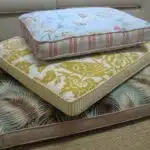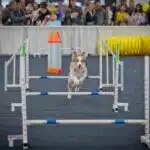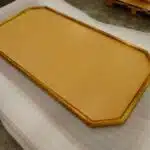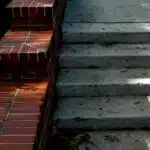Dog stairs can be a lifesaver for pet owners who have dogs that struggle with mobility, are aging, or have medical conditions. However, purchasing dog stairs can be costly and may not fit the unique needs of your furry friend. That’s where DIY dog stairs come in – they’re affordable, customizable, and easy to build. In this article, we’ll explore the steps to building your own DIY dog stairs that cater to your dog’s specific needs.
Before we dive into the nitty-gritty details of building DIY dog stairs, it’s important to understand why they’re necessary. As dogs age or develop medical conditions such as arthritis or hip dysplasia, jumping up and down from high surfaces like beds or couches becomes increasingly difficult and painful for them. Additionally, smaller breeds may struggle with reaching high surfaces due to their size. With DIY dog stairs, you can provide your furry friend with a safe and comfortable way to access high surfaces without causing them any harm or discomfort. So let’s get started on building the perfect set of custom-made dog stairs for your beloved pet!
Understanding The Benefits Of Diy Dog Stairs
Dog stairs are becoming increasingly popular among pet owners, and for good reason. There are various benefits to building your own dog stairs that go beyond just convenience. One of the most significant benefits is cost-effectiveness. Professional-grade dog stairs can be quite expensive, but with a little bit of effort and some materials, you can create your own set of dog stairs that will save you money in the long run.
Aside from saving money, DIY dog stairs also have health benefits for your furry friend. As dogs age or if they have certain health conditions like arthritis, jumping up and down from furniture or high surfaces can cause pain and discomfort. By providing your dog with their own set of customized stairs, you’re promoting better mobility for them and reducing the risk of injury.
In addition to improving your dog’s health and well-being, DIY dog stairs can also be tailored to suit the unique needs of your pet. You can choose the height, width, and depth of each step based on your dog’s size and physical abilities. This level of customization ensures that your pet will feel comfortable using their new staircase, ultimately making it easier for them to get around the house on their own.
Assessing Your Dog’s Needs
When it comes to building DIY dog stairs, assessing your dog’s needs is crucial. You want to ensure that the stairs you build will be the right size and height for your furry friend to use comfortably. Assessing your dog’s size is the first step in determining the appropriate dimensions of the stairs. Small dogs may only need a few steps, while larger dogs may require a taller set of stairs.
Assessing your dog’s mobility is also important. If your pup has arthritis or other mobility issues, you may want to consider building wider and shorter steps with lower risers. This will make it easier for them to navigate the stairs without putting too much strain on their joints. However, if your dog is young and active, you can build taller and narrower steps with higher risers.
To ensure that you build the perfect set of DIY dog stairs for your furry friend, consider these three key factors:
- Your dog’s size – this will determine the height and width of the steps
- Your dog’s mobility – this will determine the depth and angle of each step
- The location where you plan to place the stairs – this will determine how many steps you need to build.
By taking these factors into consideration, you can create a set of DIY dog stairs that are tailored specifically to meet your four-legged friend’s needs. In the next section, we’ll discuss choosing the right materials for building sturdy and safe stairs for your furry companion.
Choosing The Right Materials
Choosing the Right Materials: When it comes to building DIY dog stairs, choosing the right materials is crucial. Not only will it determine the durability and stability of the stairs, but also their appearance and eco-friendliness. The materials used can either make or break your project. Therefore, before making a purchase, there are two important factors that you need to consider: budget and eco-friendliness.
Budget Considerations: While it’s tempting to go for the cheapest option available in order to save money, this isn’t always the best idea. Low-quality materials can result in a poorly constructed stairway that could put your pet’s safety at risk. However, there are many affordable options out there that won’t compromise on quality. For instance, pine wood is a great choice if you’re on a tight budget as it’s widely available and relatively inexpensive.
Eco-Friendly Options: If you’re concerned about reducing your carbon footprint or avoiding toxic chemicals in your home, then opting for eco-friendly materials should be high on your list of priorities. One of the best options is bamboo wood which is renewable and biodegradable. It’s also incredibly strong and durable which makes it ideal for building sturdy dog stairs. Another eco-friendly option is reclaimed wood which can give your stairs an attractive rustic finish while being environmentally responsible.
With budget and eco-friendliness in mind, selecting the right material for your DIY dog stairs can be done with ease. By weighing these two critical factors against one another carefully, you’ll ensure that both you and your furry friend get exactly what you need from this project- safe and reliable steps up onto furniture or beds! Next up we’ll discuss measuring and cutting wood so stay tuned!
Measuring And Cutting Your Wood
When building diy dog stairs, it is important to choose the right type of wood. The type of wood should be based on the size and weight of the dog, as well as the aesthetic preferences for the stairs. Measuring the dimensions is crucial to ensure that the stairs are the correct size for the dog. It is recommended to measure the height and width of each step and the overall height of the stairs before cutting the wood.
Choosing The Right Wood
Selecting the right type of wood for your diy dog stairs project is vital. There are various options to choose from, such as pine, oak, cedar, and plywood. Each type has its unique characteristics that make it suitable for different purposes. When selecting the type of wood to use for building your dog stairs, consider factors such as durability and stability.
Budget considerations also play a significant role in choosing the right type of wood. Pine is an affordable option that can work well if you’re on a tight budget. However, if you’re looking for something more durable and long-lasting, oak or cedar might be a better choice despite having a higher price tag. Plywood is another option worth considering since it’s relatively inexpensive and easy to work with.
When measuring and cutting your wood for your diy dog stairs project, ensure that you take accurate measurements to avoid wastage of materials. Also, be mindful of the grain direction when cutting the wood to ensure maximum strength and stability. Additionally, using proper tools such as saws and sandpaper will help you achieve precise cuts that fit perfectly together. With careful planning and execution during the measuring and cutting stage using the right type of wood selected based on budget considerations and other factors, you can build sturdy diy dog stairs that will keep your furry friend safe while climbing up or down with ease.
Measuring The Dimensions
When it comes to building diy dog stairs, measuring the dimensions accurately is crucial. Measuring accuracy ensures that the final product fits together perfectly, and your furry friend can use it safely without any risk of injury. While measuring the height of each step, you must adjust for any variations in floor levels to ensure that all steps are at an equal height. This will help your pet climb up or down with ease and without any discomfort.
Choosing the step depth and spacing is also an essential aspect of measuring the dimensions of your dog stairs. The depth and spacing should be appropriate for your pet’s size and weight to prevent any accidents or injuries. Smaller dogs may require shallower steps with closer spacing, while larger dogs may need deeper steps with wider spacing. It’s vital to keep these factors in mind while planning out the dimensions of your diy dog stairs.
Taking accurate measurements and choosing appropriate step depth and spacing will not only ensure the safety of your pet but also enhance their comfort while using the stairs. So, take your time during this stage of planning and execution to build a sturdy set of stairs that will provide easy access for your furry friend whenever needed.
Sanding And Finishing Your Wood
After cutting and assembling the pieces of wood for your dog stairs, the next step is to sand and finish them. Sanding the wood can help smooth out any rough edges or surfaces and prepare it for staining or varnishing. To get started, you will need a few tools such as sandpaper, sanding blocks, and a dust mask to protect against airborne particles.
When it comes to staining techniques, there are several options available depending on the type of wood and desired finish. One method is to use a pre-stain conditioner to help even out the color of the wood before applying the stain. Another approach is to apply multiple coats of stain with a brush or rag, allowing each coat to dry completely before adding another layer. Whatever technique you choose, be sure to follow any instructions provided by the manufacturer for best results.
Once your stain has dried completely, it’s time to add a protective layer of varnish. Varnishing tips include using a high-quality brush or roller for application and selecting a product that is specifically designed for use on wooden surfaces. Apply one coat at a time, allowing each layer to dry fully before adding another coat. A minimum of two coats is recommended for adequate protection against wear and tear.
Next up: building the frame of your stairs!
Building The Frame Of Your Stairs
- For the frame of a DIY dog stairs project, the necessary materials include a saw, screws, wood boards, and wood glue.
- First, the wood boards should be cut to size according to the desired height and width of the stairs.
- Next, the pieces should be glued together to form the frame, and then secured with screws for added stability.
- Finally, the frame should be sanded and stained for a professional-looking finish.
Gathering Materials
To start building the frame of your dog stairs, you need to gather materials that are cost-effective and easy to find. One of the best cost-effective alternatives is using recycled wood or scrap lumber. You can also check on local hardware stores for clearance items like stair treads, railing balusters, and plywood sheets. These items can be repurposed to create a unique and practical design for your dog stairs.
Another important material you need to consider is the screws or nails that will hold your frame together. It’s best to choose durable screws or nails that are appropriate for the type of wood you’re using. Make sure that they are long enough to go through both pieces of wood without damaging them. You can also add glue between joints to make it more sturdy.
Lastly, get creative with your design ideas! Try incorporating decorative elements such as paint, stencils or pet-friendly carpeting on each step for added traction. You can even add storage compartments underneath the stairs where you can store dog toys, treats, or grooming supplies. With these creative design ideas and cost-effective alternatives in mind, you’ll be able to build a functional and stylish set of dog stairs in no time!
Making The Frame
Now that you have gathered all the necessary materials, it’s time to start making the frame of your dog stairs. The first step is to measure and cut the wood pieces according to your desired dimensions. Make sure that all pieces are of equal length and width for a uniform look. Next, assemble the frame by attaching each piece using screws or nails.
When making the frame, it’s important to ensure that each joint is secure and stable. You can add braces or crossbeams between each step for added support. Once you have assembled the frame, sand any rough edges and surfaces to prevent splinters or injuries to your furry friend.
Now comes the fun part – adding decorative accents! You can use painting techniques such as stenciling or freehand designs to add a personal touch to your dog stairs. You can also incorporate decorative elements such as pet-friendly carpeting on each step for added comfort and traction. With these tips in mind, you’ll be able to create a functional and stylish set of dog stairs that both you and your furry friend will love!
Adding Treads To Your Stairs
Once you have constructed the frame of your DIY dog stairs, it’s time to add treads. Treads are the horizontal surfaces that dogs step on as they climb up or down the stairs. These can be made from a variety of materials such as carpet, rubber, or wood. However, it is essential to choose a material that provides enough traction and is safe for your furry friend.
Safety considerations should be a top priority when selecting treads for your dog stairs. Dogs naturally run up and down stairs, so it’s crucial to select a material that provides enough traction to prevent slips and falls. If you decide to use carpet treads, ensure they are secure and free from wrinkles or loose edges that can cause tripping hazards. Rubber treads are also an excellent choice since they provide slip-resistant properties while being comfortable underfoot.
Decorating options for these treads are endless and allow you to match them with your home decor seamlessly. You can opt for fun patterns or colors that complement your home’s interior design scheme while still providing functionality for your pet. Remember not to sacrifice safety over style when choosing the perfect tread material for your DIY dog stairs project.
As we move forward with our project, attaching the treads to the frame is a crucial step in ensuring stability and safety for your pet. By securing each tread onto the frame firmly, you eliminate any potential tripping hazards or wobbling of the structure during usage. With these steps in mind, let’s move on to discuss how to attach each tread securely onto its corresponding step frame without compromising safety or aesthetics.
Attaching The Treads To The Frame
Now that the treads have been cut to size, it’s time to attach them to the frame. But before we dive into securing the treads, it’s important to consider the types of treads available. The most common materials used for dog stairs are carpet, wood, and foam.
Carpet treads offer a soft surface for your dog to walk on and can be easily removed for cleaning. Wood treads provide a sturdy and durable option but may require extra safety precautions such as sanding or adding non-slip tape. Foam treads are lightweight and gentle on paws but may not hold up as well over time.
When securing the treads to the frame, there are a few tips to keep in mind. Firstly, make sure each tread is level before attaching it to the frame. This will ensure that your dog feels comfortable walking up and down the stairs without any unexpected bumps or dips. Secondly, use screws or nails that are appropriate for your chosen material and make sure they are long enough to securely hold each tread in place. Finally, consider using wood glue in addition to screws or nails for added stability.
- Types of treads: Carpet, wood, foam
- Tips for securing treads: Ensure each tread is level before attaching it, use appropriate screws or nails, consider using wood glue for added stability, add non-slip tape if necessary
As an expert in building diy dog stairs, it’s important to prioritize safety when creating these structures for our furry friends. By carefully selecting the type of tread and taking extra precautions when securing them in place, you can ensure that your dog has a safe and comfortable way of accessing higher surfaces.
In order to further increase safety measures on your dog stairs, creating a non-slip surface is crucial. In the next section we’ll explore different ways you can achieve this while still maintaining a visually appealing design.
Creating A Non-Slip Surface
As the saying goes, “prevention is better than cure.” This adage is especially true when it comes to building dog stairs. One of the most important safety considerations is creating a non-slip surface. Without it, your furry friend could slip and fall, potentially causing injury.
To ensure that your dog stairs are safe and secure, use non-slip materials for the treads. Rubber mats or carpet runners with rubber backing work well as they provide excellent traction while also being durable enough to withstand frequent use. Cut them to size and attach them securely to each step using an adhesive suitable for the material.
Another option for a non-slip surface is to apply a coat of anti-slip paint. This can be purchased at most hardware stores and is specifically designed for high-traffic areas such as stairs. Just make sure to follow the manufacturer’s instructions carefully when applying it.
Table: Non-Slip Materials Comparison
| Material | Pros | Cons |
|---|---|---|
| Rubber Mats | Excellent traction, Durable | Can be expensive |
| Carpet Runners with Rubber Backing | Good traction, Affordable | Can be difficult to clean |
| Anti-Slip Paint | Easy to apply, Suitable for high-traffic areas | May need frequent reapplication |
Now that you’ve created a non-slip surface for your dog stairs, you can rest assured that your furry friend will be able to navigate them safely. In the next section, we’ll discuss adding finishing touches to make your DIY dog stairs both functional and aesthetically pleasing.
Adding Finishing Touches
Now that your DIY dog stairs are assembled and functional, it’s time to add some finishing touches to make them look great in your home. Painting the stairs is an option for those who want to give them a polished look. If you choose this option, be sure to use a pet-safe paint and let it dry completely before allowing your furry friend to use the stairs.
Another way to add some style to your dog stairs is by incorporating decorative accents. You can add carpet treads or stair runners for extra grip and comfort for your dog. Or, you can attach decorative trim or molding along the sides of the stairs for a more elegant touch. Whatever accents you choose, make sure they are securely attached so they don’t become tripping hazards.
Remember that safety is always key when it comes to building any type of furniture for pets. Once you have completed adding the finishing touches, it’s important to test your stairs for stability and durability. Have your dog test them out and make sure they are secure enough to hold their weight without wobbling or tipping over. With these final touches and safety measures in place, your DIY dog stairs will be both functional and stylish additions to your home!
Testing Your Stairs For Safety
Picture this: you’ve just finished building a set of dog stairs for your furry companion. You’re excited to see him climb up and down with ease, but before you do, it’s important to test the stairs for safety. Stair stability is crucial in ensuring that your dog won’t tumble and hurt himself while using the stairs.
To start, give the stairs a good shake. If they wobble or feel unsteady, reinforce them with additional screws or brackets. Next, test the weight capacity by placing an object of similar weight as your dog on the stairs. If they hold up well, it’s time to introduce your pup to his new staircase.
Once your dog starts using the stairs, keep an eye on their behavior. If they seem hesitant or nervous about climbing up and down, it may be a sign that the stairs need further adjustments. Remember that every dog is different and may require different modifications to ensure their comfort and safety while using the stairs.
With stair stability and weight capacity tested and confirmed, you can rest easy knowing that your furry friend has a safe way of accessing elevated surfaces in your home. But don’t stop there! Keep reading to learn how you can adjust the stairs for optimal comfort for your furry best friend.
Adjusting Your Stairs For Your Dog’s Comfort
After testing your stairs for safety, the next step is to make adjustments for your dog’s comfort. One important factor to consider is the height of the stairs. Make sure that each step is not too high or too low for your furry friend. The ideal height of each step should be around 6-7 inches, but this may vary depending on the size and breed of your dog.
Another thing to keep in mind when adjusting your stairs is the angle of each step. Steep steps may be difficult for some dogs to climb, so it’s important to make sure they are at a comfortable angle. A good rule of thumb is to keep the angle between 30-40 degrees. You can adjust the angle by either adding or removing steps or by changing the length and height of each individual step.
Overall, making adjustments to ensure your dog’s comfort while using the stairs is crucial in ensuring their safety and well-being. Taking into consideration factors such as height and stair angle will provide a more comfortable experience for your canine companion, ultimately leading to a happier and healthier lifestyle. In the next section, we will discuss how to properly clean and maintain your DIY dog stairs to ensure their longevity and continued use by your furry friend.
Cleaning And Maintaining Your Diy Dog Stairs
As a diy dog stairs expert, it is important to not only focus on building the stairs but also ensure that they are properly cleaned and maintained. After all, you want your furry friend to have access to a clean and safe path to their favorite spots. One way to keep your dog stairs looking good as new is by choosing the right stain option. Staining your stairs not only enhances their aesthetic appeal, but it also protects the wood from wear and tear.
When it comes to cleaning your DIY dog stairs, regular maintenance is key. Start by removing any debris or dirt with a soft brush or vacuum cleaner. You can then use a mild soap solution and warm water to wipe down the stairs gently. Avoid using harsh chemicals or abrasive materials that could damage the wood surface. Once you’ve cleaned the entire staircase, let it air dry completely before allowing your pet to use them again.
In addition to regular cleaning, there are some tips that can help you maintain your DIY dog stairs over time. For instance, make sure to keep them away from direct sunlight or humidity as these can cause warping or discoloration of the wood. It’s also important to check for any loose screws or nails periodically and tighten them if necessary. By following these simple steps, you can ensure that your dog stairs last for years without needing any major repairs.
To troubleshoot common issues with DIY dog stairs, there are several things you can do such as inspecting for loose parts or checking if there are any signs of wear and tear on the surface of each step. Additionally, if you notice that your pet is having difficulty climbing up or down the staircase, it’s recommended that you consult with a veterinarian in case there’s an underlying health issue causing this behavior. With proper care and maintenance, however, most issues can be easily resolved so that your furry friend can continue enjoying their new set of custom-built dog stairs!
Troubleshooting Common Issues
- In order to diagnose problem areas in a DIY dog stairs design, it is important to observe the existing structure, its components, and the material used.
- Common flaws in DIY dog stairs design include improper angles, inadequate support, and insufficient spacing between steps.
- To fix these design flaws, adjustments can be made to the angles and supports, and additional steps can be added if necessary.
- It is also important to consider the weight of the animal using the stairs and the material used to ensure the safety and stability of the structure.
Diagnosing Problem Areas
When it comes to building DIY dog stairs, diagnosing safety issues is an essential step. The last thing you want is for your furry friend to get injured while using the stairs. To avoid this, inspect each part of the stairs thoroughly and identify any potential hazards. Check for loose screws, unstable platforms, or uneven steps that could cause your dog to trip or fall.
Troubleshooting design is another aspect of diagnosing problem areas when building DIY dog stairs. While designing the stairs, ensure that they are the right size for your dog’s needs. The height of each step should be comfortable for your pet to climb up and down without straining their joints. Also, consider the overall structure of the stairs and make sure they are sturdy enough to support your dog’s weight.
One crucial tip when diagnosing problem areas in DIY dog stairs is to test them out yourself before introducing them to your pet. Climb up and down the steps several times and feel for any wobbling or instability. This way, you can be confident that the stairs are safe and secure before allowing your furry friend to use them. By taking these necessary precautions during construction, you can ensure that your DIY dog stairs will provide a comfortable and safe way for your pet to access high places around the house.
Fixing Stair Design Flaws
As a DIY dog stairs expert, one common flaw in stair design is uneven steps. This can cause discomfort, strain, and even injuries to your furry friend. To fix this issue, measure each step’s height and ensure that they are consistent throughout the staircase. You can use a level tool or ruler to double-check the height of each step. If you notice any variations, adjust them by sanding down or adding extra material until they are all the same height.
Another crucial aspect of fixing stair design flaws is improving stability and durability. A wobbling or unstable staircase can be dangerous for your pet, especially if they are older or have mobility issues. To improve stability, ensure that each step is securely attached to the frame with screws or glue. You can also add support beams underneath the stairs for added strength and resilience.
Lastly, consider using high-quality materials when building your DIY dog stairs to improve their durability. For instance, solid wood or plywood is sturdy enough to withstand frequent use and can last for years without needing repairs. Additionally, you can apply a protective finish such as paint or varnish to prevent wear and tear from scratches and moisture damage. By fixing uneven steps, improving stability and durability, you can create safe and comfortable DIY dog stairs that your furry friend will enjoy using for many years to come.
Enjoying Your Custom-Built Diy Dog Stairs!
Now that you have built your custom DIY dog stairs, it is time to enjoy them with your furry friend. One of the benefits of building your own dog stairs is the ability to create unique designs that incorporate your home decor. You can choose from a variety of materials such as wood, carpet, or even repurposed items to match your style.
Training your dog to use the stairs may take some patience and positive reinforcement, but it will promote their independence and mobility. Start by placing treats on each step and encouraging them to climb up and down. Once they are comfortable with the stairs, remove the treats and continue to praise them for using the stairs independently.
With proper training and supervision, your dog will soon be using their new stairs with ease. Not only will this provide them with easier access to higher areas in your home, it can also prevent injuries from jumping or climbing. Enjoy watching your furry friend navigate their new space with confidence and comfort.
- Experiment with different styles and colors to create a personalized look for your home.
- Use non-slip materials on each step for added safety.
- Consider adding a small landing area at the top of the stairs for easy access onto furniture or beds.
Conclusion
DIY dog stairs can be a fun and rewarding project for any pet owner who wants to provide their furry friend with easy access to high places. By choosing the right materials, measuring carefully, and taking your dog’s needs into account, you can create a set of stairs that is both functional and stylish.
One of the key benefits of DIY dog stairs is the ability to customize them to your pet’s specific needs. Whether your dog is elderly or has mobility issues, or simply needs a little help getting onto the couch or bed, creating a set of stairs just for them can make all the difference. And by building it yourself, you also have the satisfaction of knowing that you created something unique and special for your beloved companion.
So why not take on this rewarding project today? With a little bit of planning and effort, you can create a set of DIY dog stairs that will make your pet’s life easier and more comfortable. And every time they climb up those stairs with ease, you’ll feel proud of what you’ve accomplished – not just as a DIY enthusiast but as a dedicated pet owner who truly cares about their four-legged friend.
Image Credits
- “dog leap stairs” by ChrisPerriman (featured)


















![How To Repair Rotted Wood 19 Texture : Altario Buick Estate Wagon : Rotting Faux Wood Paneling [1 of 2]](https://green-life.blog/wp-content/uploads/2023/05/z1CersK-gCjq-150x150.jpg.webp)








![How To Build A Detached Deck 28 Force Reconnaissance Detachment Deck Shoot [Image 4 of 4]](https://green-life.blog/wp-content/uploads/2023/05/RJo3tlizSGjq-150x150.jpg.webp)

